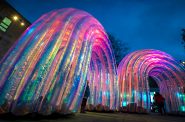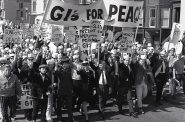Grohmann Museum’s “Working Legacies”
It was the day after our first snowstorm, a Friday, and all is well in downtown Milwaukee, that is, until I arrive to review the current exhibition, Working Legacies, at the Grohmann Museum, 1000 N. Broadway. The sign on the door, printed in big black font, reads: No Weapons of Any Kind Permitted Inside.
So much has changed in Milwaukee, and David Schalliol’s and historian Michael Carriere’s photographs and texts on floor two tell at least part of the story about the decline of industry here. It’s a tale told across the United States, but this tale is focused on Milwaukee. I’ve visited the museum on several occasions and have come to the conclusion that it is most valuable for the history it presents, be that writ in paint, forged in bronze or captured on photographic prints.
Of course, the exhibition of photographs can be enjoyed from the perspective of art photography, but that would be a mistake. The closest thing to that genre is an image of a mountain of salt. It borders on abstraction, but the rest of Schalliol’s images are primarily straightforward and no-nonsense, like the blue-collar community that populated the brick structures he depicts. On the north wall is a photograph of the glassy offices of ThirdCoast Digest, now in the former Laura Ashley store at the Grand Avenue Mall, as an example of space given new life and purpose.
While studying the work, I noticed a group of four gentlemen arriving, and attached myself to one of them, a 74-year-old Cedarburg chap who had driven in with some buddies (including Karl Kopp of Elsa’s fame) to see the exhibition. Mr. Jung and I we stood in front of an image of the shuttered Solvay plant. He said his childhood home was heated with coke produced at the plant. He talks about meeting his wife when they were both in kindergarten at St. Elizabeth’s. Mr. Jung was a purchasing agent in the old days, and his son currently teaches history at MSOE.
“I could cry when I look at some of these photographs,” he says, adding that the artistic aspects of the work don’t interest him. It’s the story behind the images that move him to almost-tears. We move through the exhibition and chat about the loss of neighborhoods where houses, churches and schools were a solid part of Milwaukee. That’s how he remembers it. Neighborhoods grew where industry grew.
Working Legacies: The Death and (After) Life of Post-Industrial Milwaukee, photos and histories by David Schalliol and Michael Carriere, runs through Feb.6. The Grohmann will be open from 5 to 9 p.m. Gallery Night, Friday, Jan. 20.
Art
-
Winning Artists Works on Display
 May 30th, 2024 by Annie Raab
May 30th, 2024 by Annie Raab
-
5 Huge Rainbow Arcs Coming To Downtown
 Apr 29th, 2024 by Jeramey Jannene
Apr 29th, 2024 by Jeramey Jannene
-
Exhibit Tells Story of Vietnam War Resistors in the Military
 Mar 29th, 2024 by Bill Christofferson
Mar 29th, 2024 by Bill Christofferson






















